The Landscapes of Sustainability in Library and Information Science: Diachronous Citation Perspective
Abstract
1. Introduction
- Q1:
- What does the lifecycle of a publication in the sustainable LIS specialty look like when viewed from the perspective of a diachronous citation analysis?
- Q2:
- Which research topics are currently gaining popularity, and which are fading away in the landscape of sustainable LIS science?
- Q3:
- Which subdomains of sustainable LIS are cited by which other scientific disciplines the most, i.e., what are the properties of the diachronous citation network in terms of the distribution of the direct citation links connecting some particular fields of study?
- Q4:
- What is the overall quantitative and qualitative picture of the current state of the sustainable LIS specialty, based on bibliometric methods of analysis?
2. Background
3. Materials and Methods
3.1. Data Sources
( TITLE-ABS-KEY ( sustainab* )
AND ( TITLE ( library OR librari*
OR "information scienc*" ) )
)
AND ( LIMIT-TO ( DOCTYPE , "ar" )
OR LIMIT-TO ( DOCTYPE , "cp" ) OR LIMIT-TO ( DOCTYPE , "ch" )
OR LIMIT-TO ( DOCTYPE , "bk" )
)
3.2. Data Acquisition, Cleaning and Preprocessing
3.3. Diachronous and Network Analysis
- Information and ICT;
- Collections;
- Buildings;
- Education;
- Culture;
- Other.
4. Results
5. Limitations of the Study
6. Discussion
6.1. The Lifecycle Perspective (Q1)
6.2. Dynamics of Development of LIS Research Areas (Q2)
6.3. LIS Domain Contribution to Other Branches of Science (Q3)
6.4. Overall LIS Landscape Emerging from Present Study (Q4)
7. Conclusions
Author Contributions
Funding
Data Availability Statement
Conflicts of Interest
References
- Spink, A. Information and a sustainable future. Libri 1995, 45, 203–208. [Google Scholar] [CrossRef]
- Elepov, B.S.; Lavrik, O.L. The library and the problems of sustainable development. Resour. Shar. Inf. Netw. 1997, 13, 85–94. [Google Scholar] [CrossRef]
- Eschenfelder, K.R.; Shankar, K.; Williams, R.; Lanham, A.; Salo, D.; Zhang, M. What are we talking about when we talk about sustainability of digital archives, repositories and libraries? Proc. Assoc. Inf. Sci. Technol. 2016, 53, 1–6. [Google Scholar] [CrossRef]
- Hoq, K.M.G. Rural library and information services, their success, failure and sustainability: A literature review. Inf. Dev. 2015, 31, 294–310. [Google Scholar] [CrossRef]
- Izuagbe, R. Pricing Implication of Publishers’ Licensing Models on Sustainable E-resources Integration in Academic Libraries: A Review. Int. J. Inf. Sci. Manag. (IJISM) 2017, 15, 79–88. [Google Scholar]
- Kamińska, A.M.; Opaliński, L.; Wyciślik, L. The Landscapes of Sustainability in the Library and Information Science: Systematic Literature Review. Sustainability 2022, 14, 441. [Google Scholar] [CrossRef]
- Kamińska, A.M.; Opaliński, L.; Wyciślik, L. The Landscapes of Sustainability in the Library and Information Science: Collaboration Insights. Sustainability 2022, 14, 6818. [Google Scholar] [CrossRef]
- Khalid, A.; Farid, G.; Mahmood, K. Sustainable development challenges in libraries: A systematic literature review (2000–2020). J. Acad. Librariansh. 2021, 47, 102347. [Google Scholar] [CrossRef]
- Mathiasson, M.H.; Jochumsen, H. Libraries, sustainability and sustainable development: A review of the research literature. J. Doc. 2022, 78, 1278–1304. [Google Scholar] [CrossRef]
- Meschede, C.; Henkel, M. Library and information science and sustainable development: A structured literature review. J. Doc. 2019, 75, 1356–1369. [Google Scholar] [CrossRef]
- THE 17 GOALS. Available online: https://sdgs.un.org/goals (accessed on 26 July 2023).
- Hawkes, J. The Fourth Pillar of Sustainability: Culture’s Essential Role in Public Planning; Common Ground P/L: Melbourne, Australia, 2001. [Google Scholar]
- The Future We Want. 2012. Available online: https://wedocs.unep.org/bitstream/handle/20.500.11822/13662/N1238164.pdf (accessed on 26 July 2023).
- Let Us Work Together for the Future. 2021. Available online: https://www.eifl.net/events/ifla-wlic-2021 (accessed on 26 July 2023).
- Bettencourt, L.M.A.; Kaur, J. Evolution and structure of sustainability science. Proc. Natl. Acad. Sci. USA 2011, 108, 19540–19545. [Google Scholar] [CrossRef] [PubMed]
- Quental, N.; Lourenço, J. References, authors, journals and scientific disciplines underlying the sustainable development literature: A citation analysis. Scientometrics 2012, 90, 361–381. [Google Scholar] [CrossRef]
- Schoolman, E.; Guest, J.; Bush, K.; Bell, A. How interdisciplinary is sustainability research? Analyzing the structure of an emerging scientific field. Sustain. Sci. 2012, 7, 67–80. [Google Scholar] [CrossRef]
- Buter, R.K.; Van Raan, A.F.J. Identification and analysis of the highly cited knowledge base of sustainability science. Sustain. Sci. 2013, 8, 253–367. [Google Scholar] [CrossRef]
- Wichaisri, S.; Sopadang, A. Trends and future directions in sustainable development. Sustain. Dev. 2018, 26, 1–17. [Google Scholar] [CrossRef]
- Farrukh, M.; Meng, F.; Raza, A.; Tahir, M.S. Twenty-seven years of Sustainable Development Journal: A bibliometric analysis. Sustain. Dev. 2020, 28, 1725–1737. [Google Scholar] [CrossRef]
- Sianes, A.; Vega-Muñoz, A.; Tirado-Valencia, P.; Ariza-Montes, A. Impact of the Sustainable Development Goals on the academic research agenda. A scientometric analysis. PLoS ONE 2022, 17, e0265409. [Google Scholar] [CrossRef]
- Meschede, C.; Henkel, M. Information science research and sustainable development. Proc. Assoc. Inf. Sci. Technol. 2018, 55, 871–872. [Google Scholar] [CrossRef]
- Goodchild, M.; Zhao, J. Sustainability engineering collection assessment: A mixed-method analysis. Sci. Technol. Libr. 2017, 36, 153–169. [Google Scholar] [CrossRef]
- Repanovici, A.; Rotaru, C.S.; Murzea, C. Development of sustainable thinking by information literacy. Sustainability 2021, 13, 1287. [Google Scholar] [CrossRef]
- Beutelspacher, L.; Meschede, C. Libraries as promoters of environmental sustainability: Collections, tools and events. Int. Fed. Libr. Assoc. Institutions J. 2020, 46, 347–358. [Google Scholar] [CrossRef]
- Van Eck, N.J.; Waltman, L. VOSviewer Manual. 2020. Available online: https://www.vosviewer.com/documentation/Manual_VOSviewer_1.6.20.pdf (accessed on 29 January 2022).
- Ensslin, L.; Dutra, A.; Ensslin, S.R.; Moreno, E.A.; Chaves, L.C.; Longaray, A.A. Sustainability in library management in higher education institutions: A bibliometric analysis. Int. J. Sustain. High. Educ. 2022, 23, 1685–1708. [Google Scholar] [CrossRef]
- Fedorowicz-Kruszewska, M. Green library as a subject of research–a quantitative and qualitative perspective. J. Doc. 2021, 78, 912–932. [Google Scholar] [CrossRef]
- Li, S.; Yang, F. Green Library Research: A Bibliometric Analysis. Public Libr. Q. 2023, 42, 424–443. [Google Scholar] [CrossRef]
- Ferreira Gregorio, V.; Pié, L.; Terceño, A. A Systematic Literature Review of Bio, Green and Circular Economy Trends in Publications in the Field of Economics and Business Management. Sustainability 2018, 10, 4232. [Google Scholar] [CrossRef]
- Álvarez-Llorente, J.M.; Guerrero-Bote, V.P.; de Moya-Anegón, F. New fractional classifications of papers based on two generations of references and on the ASJC scopus scheme. Scientometrics 2024, 129, 3493–3515. [Google Scholar] [CrossRef]
- Finardi, U. On the time evolution of received citations, in different scientific fields: An empirical study. J. Inf. 2014, 8, 13–24. [Google Scholar] [CrossRef]
- Small, H. Co-citation in the scientific literature: A new measure of the relationship between two documents. J. Am. Soc. Inf. Sci. 1973, 24, 265–269. [Google Scholar] [CrossRef]
- Marshakova, I.V. System of document connections based on references. Nauchno-Tekhnicheskaya Informatsiya Seriya 2-Informatsionnye Protsessy Sist. 1973, 6, 3–8. [Google Scholar]
- Wang, B.; Bu, Y.; bin Huang, W. Document- and Keyword-based Author Co-citation Analysis. Data Inf. Manag. 2018, 2, 70–82. [Google Scholar] [CrossRef]
- Boyack, K.W.; Klavans, R. Co-citation analysis, bibliographic coupling, and direct citation: Which citation approach represents the research front most accurately? J. Am. Soc. Inf. Sci. Technol. 2010, 61, 2389–2404. [Google Scholar] [CrossRef]
- Hou, J.; Yang, X.; Chen, C. Emerging trends and new developments in information science: A document co-citation analysis (2009–2016). Scientometrics 2018, 115, 869–892. [Google Scholar] [CrossRef]
- Jeong, Y.K.; Song, M.; Ding, Y. Content-based author co-citation analysis. J. Inf. 2014, 8, 197–211. [Google Scholar] [CrossRef]
- McCain, K.W. Neural networks research in context: A longitudinal journal cocitation analysis of an emerging interdisciplinary field. Scientometrics 1998, 41, 389–410. [Google Scholar] [CrossRef]
- Mustafee, N.; Katsaliaki, K.; Fishwick, P. Exploring the modelling and simulation knowledge base through journal co-citation analysis. Scientometrics 2014, 98, 2145–2159. [Google Scholar] [CrossRef]
- Small, H.; Griffith, B.C. The Structure of Scientific Literatures I: Identifying and Graphing Specialties. Sci. Stud. 1974, 4, 17–40. [Google Scholar] [CrossRef]
- Zitt, M.; Bassecoulard, E. Reassessment of co-citation methods for science indicators: Effect of methods improving recall rates. Scientometrics 1996, 37, 223–244. [Google Scholar] [CrossRef]
- Perianes-Rodriguez, A.; Waltman, L.; van Eck, N.J. Constructing bibliometric networks: A comparison between full and fractional counting. J. Inf. 2016, 10, 1178–1195. [Google Scholar] [CrossRef]
- Delgado López-Cózar, E.; Orduña-Malea, E.; Martín-Martín, A. Google Scholar as a data source for research assessment. In Springer Handbook of Science and Technology Indicators; Springer: New York, NY, USA, 2019; pp. 95–127. [Google Scholar]
- Orduna-Malea, E.; Martín-Martín, A.; López-Cózar, E.D. Google Scholar como una fuente de evaluación científica: Una revisión bibliográfica sobre errores de la base de datos. Revista Española de Documentación Científica 2017, 40, e185. [Google Scholar] [CrossRef]
- Prins, A.A.; Costas, R.; van Leeuwen, T.N.; Wouters, P.F. Using Google Scholar in research evaluation of humanities and social science programs: A comparison with Web of Science data. Res. Eval. 2016, 25, 264–270. [Google Scholar] [CrossRef]
- Singh, V.K.; Singh, P.; Karmakar, M.; Leta, J.; Mayr, P. The journal coverage of Web of Science, Scopus and Dimensions: A comparative analysis. Scientometrics 2021, 126, 5113–5142. [Google Scholar] [CrossRef]
- Visser, M.; van Eck, N.J.; Waltman, L. Large-scale comparison of bibliographic data sources: Scopus, Web of Science, Dimensions, Crossref, and Microsoft Academic. Quant. Sci. Stud. 2021, 2, 20–41. [Google Scholar] [CrossRef]
- Yang, K.; Meho, L.I. Citation analysis: A comparison of Google Scholar, Scopus, and Web of Science. Proc. Am. Soc. Inf. Sci. Technol. 2006, 43, 1–15. [Google Scholar] [CrossRef]
- Avramescu, A. Actuality and Obsolescence of Scientific Literature. J. Am. Soc. Inf. Sci. 1979, 30, 296–303. [Google Scholar] [CrossRef]
- Borgman, C.L.; Furner, J. Scholarly communication and bibliometrics. Annu. Rev. Inf. Sci. Technol. 2002, 36, 2–72. [Google Scholar] [CrossRef]
- Bornmann, L.; Daniel, H.D. What do citation counts measure? A review of studies on citing behavior. J. Doc. 2008, 64, 45–80. [Google Scholar] [CrossRef]
- Bornmann, L.; Mutz, R.; Neuhaus, C.; Daniel, H.D. Citation counts for research evaluation: Standards of good practice for analyzing bibliometric data and presenting and interpreting results. Ethics Sci. Environ. Politics 2008, 8, 93–102. [Google Scholar] [CrossRef]
- Erikson, M.G.; Erlandson, P. A taxonomy of motives to cite. Soc. Stud. Sci. 2014, 44, 625–637. [Google Scholar] [CrossRef] [PubMed]
- Kochen, M. How well do we acknowledge intellectual debts? J. Doc. 1987, 43, 54–64. [Google Scholar] [CrossRef]
- Kostoff, R. The use and misuse of citation analysis in research evaluation. Scientometrics 1998, 43, 27–43. [Google Scholar] [CrossRef]
- Merton, R.K. The Sociology of Science; Theoretical and Empirical Investigations; The University of Chicago Press: Chicago, IL, USA, 1979; pp. 267–278. [Google Scholar]
- Moed, H.F. Citation Analysis in Research Evaluation; Springer Science & Business Media: Berlin/Heidelberg, Germany, 2006; Volume 9. [Google Scholar]
- Nicolaisen, J. Citation analysis. Annu. Rev. Inf. Sci. Technol. 2007, 41, 609–641. [Google Scholar] [CrossRef]
- Tahamtan, I.; Bornmann, L. What do citation counts measure? An updated review of studies on citations in scientific documents published between 2006 and 2018. Scientometrics 2019, 121, 1635–1684. [Google Scholar] [CrossRef]
- Albort-Morant, G.; Henseler, J.; Leal-Millán, A.; Cepeda-Carrión, G. Mapping the Field: A Bibliometric Analysis of Green Innovation. Sustainability 2017, 9, 1011. [Google Scholar] [CrossRef]
- Ellili, N.O.D. Bibliometric analysis of sustainability papers: Evidence from Environment, Development and sustainability. Environ. Dev. Sustain. 2024, 26, 8183–8209. [Google Scholar] [CrossRef] [PubMed]
- Tang, M.; Liao, H.; Wan, Z.; Herrera-Viedma, E.; Rosen, M.A. Ten Years of Sustainability (2009 to 2018): A Bibliometric Overview. Sustainability 2018, 10, 1655. [Google Scholar] [CrossRef]
- Garfield, E. “Science Citation Index”—A New Dimension in Indexing: This unique approach underlies versatile bibliographic systems for communicating and evaluating information. Science 1964, 144, 649–654. [Google Scholar] [CrossRef]
- Goodwin, J. Citation Indexing—Its Theory and Application in Science, Technology, and Humanities by Eugene Garfield. Technol. Cult. 1980, 21, 714–715. [Google Scholar] [CrossRef]
- Garfield, E. Is citation analysis a legitimate evaluation tool? Scientometrics 1979, 1, 359–375. [Google Scholar] [CrossRef]
- Cole, S. Making Science: Between Nature and Society; Harvard University Press: Cambridge, MA, USA, 1992. [Google Scholar]
- Nederhof, A.; Van Raan, A. Citation theory and the Ortega hypothesis. Scientometrics 1987, 12, 325–328. [Google Scholar] [CrossRef]
- White, H. Author Co-Citation Analysis: Overview and Defense; Scholoarly Communication and Bibliometrics; Sage Publication: Thousand Oaks, CA, USA, 1990. [Google Scholar]
- Bouabid, H.; Larivière, V. The lengthening of papers’ life expectancy: A diachronous analysis. Scientometrics 2013, 97, 695–717. [Google Scholar] [CrossRef]
- Burton, R.E.; Kebler, R.W. The “half-life” of some scientific and technical literatures. Am. Doc. 1960, 11, 18–22. [Google Scholar] [CrossRef]
- Chi, P.S.; Glänzel, W. An article-based cross-disciplinary study of reference literature for indicator improvement. Scientometrics 2022, 127, 7077–7089. [Google Scholar] [CrossRef]
- Dorta-González, P.; Gómez-Déniz, E. Modeling the obsolescence of research literature in disciplinary journals through the age of their cited references. Scientometrics 2022, 127, 2901–2931. [Google Scholar] [CrossRef]
- Galiani, S.; Gálvez, R.H. An empirical approach based on quantile regression for estimating citation aging. J. Inf. 2019, 13, 738–750. [Google Scholar] [CrossRef]
- Gilyarevskii, R.; Libkind, A.; Libkind, I.; Bogorov, V. The obsolescence of cited and citing journals: Half-lives and their connection to other bibliometric indicators. Autom. Doc. Math. Linguist. 2021, 55, 152–165. [Google Scholar] [CrossRef]
- Glänzel, W.; Schoepflin, U. A bibliometric study of reference literature in the sciences and social sciences. Inf. Process. Manag. 1999, 35, 31–44. [Google Scholar] [CrossRef]
- Price, D.J. Citation measures of hard science, soft science, technology, and nonscience. Commun. Sci. Eng. 1970, 1, 3r22. [Google Scholar]
- Wang, J. Citation time window choice for research impact evaluation. Scientometrics 2013, 94, 851–872. [Google Scholar] [CrossRef]
- Dorta-Gonzalez, P.; Dorta-González, M.I. Impact maturity times and citation time windows: The 2-year maximum journal impact factor. J. Inf. 2013, 7, 593–602. [Google Scholar] [CrossRef]
- Moed, H.F. Measuring contextual citation impact of scientific journals. J. Inf. 2010, 4, 265–277. [Google Scholar] [CrossRef]
- Waltman, L.; van Eck, N.J.; Van Leeuwen, T.N.; Visser, M.S. Some modifications to the SNIP journal impact indicator. J. Inf. 2013, 7, 272–285. [Google Scholar] [CrossRef]
- Improved Citescore. 2023. Available online: https://blog.scopus.com/posts/citescore-2023-a-comprehensive-clear-and-current-metric-for-journal-impact (accessed on 24 July 2022).
- Line, M.B.; Sandison, A. PROGRESS IN DOCUMENTATION: ‘obsolescence’and changes in the use of literature with time. J. Doc. 1974, 30, 283–350. [Google Scholar] [CrossRef]
- Liu, Y.; Qin, C.; Ma, X.; Liang, H. Serendipity in human information behavior: A systematic review. J. Doc. 2022, 78, 435–462. [Google Scholar] [CrossRef]
- Franceschet, M. The skewness of computer science. Inf. Process. Manag. 2011, 47, 117–124. [Google Scholar] [CrossRef]
- Lisée, C.; Larivière, V.; Archambault, É. Conference proceedings as a source of scientific information: A bibliometric analysis. J. Am. Soc. Inf. Sci. Technol. 2008, 59, 1776–1784. [Google Scholar] [CrossRef]
- Sjøberg, D.I.K. Confronting the myth of rapid obsolescence in computing research. Commun. ACM 2010, 53, 62–67. [Google Scholar] [CrossRef]
- Raju, N.G. Obsolescence of literature in library and information science research. Int. J. Inf. Dissem. Technol. 2018, 8, 170–174. [Google Scholar] [CrossRef]
- Song, R.; Giunchiglia, F.; Li, Y.; Shi, L.; Xu, H. Measuring and mitigating language model biases in abusive language detection. Inf. Process. Manag. 2023, 60, 103277. [Google Scholar] [CrossRef]
- Verstak, A.; Acharya, A.; Suzuki, H.; Henderson, S.; Iakhiaev, M.; Lin, C.C.Y.; Shetty, N. On the shoulders of giants: The growing impact of older articles. arXiv 2014, arXiv:1411.0275. [Google Scholar]
- Zhang, L.; Glänzel, W. A citation-based cross-disciplinary study on literature aging: Part I—The synchronous approach. Scientometrics 2017, 111, 1573–1589. [Google Scholar] [CrossRef]
- Bornmann, L.; Daniel, H.D. Citation speed as a measure to predict the attention an article receives: An investigation of the validity of editorial decisions at Angewandte Chemie International Edition. J. Inf. 2010, 4, 83–88. [Google Scholar] [CrossRef]
- Egghe, L. A heuristic study of the first-citation distribution. Scientometrics 2000, 48, 345–359. [Google Scholar] [CrossRef]
- Aksnes, D.W. Characteristics of highly cited papers. Res. Eval. 2003, 12, 159–170. [Google Scholar] [CrossRef]
- Aksnes, D.W. Citation rates and perceptions of scientific contribution. J. Am. Soc. Inf. Sci. Technol. 2006, 57, 169–185. [Google Scholar] [CrossRef]
- Onodera, N.; Yoshikane, F. Factors affecting citation rates of research articles. J. Assoc. Inf. Sci. Technol. 2015, 66, 739–764. [Google Scholar] [CrossRef]
- Bücheler, T.; Sieg, J.H. Understanding Science 2.0: Crowdsourcing and Open Innovation in the Scientific Method. Procedia Comput. Sci. 2011, 7, 327–329. [Google Scholar] [CrossRef]
- Dessein, J. Culture in, for and as Sustainable Development: Conclusions from the COST ACtion IS1007 Investigating Cultural Sustainability; Univerity of Jyvaskyla: Jyvaskyla, Finland, 2015. [Google Scholar]
- Opoku, A. The Role of Culture in a Sustainable Built Environment. In Sustainable Operations Management: Advances in Strategy and Methodology; Springer International Publishing: Cham, Switzeralnd, 2015; pp. 37–52. [Google Scholar] [CrossRef]
- Soini, K.; Birkeland, I. Exploring the scientific discourse on cultural sustainability. Geoforum 2014, 51, 213–223. [Google Scholar] [CrossRef]
- Gou, Z.; Meng, F.; Chinchilla-Rodríguez, Z.; Bu, Y. Encoding the citation life-cycle: The operationalization of a literature-aging conceptual model. Scientometrics 2022, 127, 5027–5052. [Google Scholar] [CrossRef]
- Nederhof, A.J. Bibliometric monitoring of research performance in the social sciences and the humanities: A review. Scientometrics 2006, 66, 81–100. [Google Scholar] [CrossRef]
- Zhang, L. Analyzing Citation and Research Collaboration Characteristics of Faculty in Aerospace, Civil and Environmental, Electrical and Computer, and Mechanical Engineering. Coll. Res. Libr. 2018, 79, 158. [Google Scholar] [CrossRef]
- Harasim, L. A History of E-learning: Shift Happened. In The International Handbook of Virtual Learning Environments; Weiss, J., Nolan, J., Hunsinger, J., Trifonas, P., Eds.; Springer: Dordrecht, The Netherlands, 2006; pp. 59–94. [Google Scholar] [CrossRef]
- Nicholson, P. A History of E-Learning. In Computers and Education: E-Learning, From Theory to Practice; Fernández-Manjón, B., Sánchez-Pérez, J.M., Gómez-Pulido, J.A., Vega-Rodríguez, M.A., Bravo-Rodríguez, J., Eds.; Springer: Dordrecht, The Netherlands, 2007; pp. 1–11. [Google Scholar] [CrossRef]
- Gomes, C.; Dietterich, T.; Barrett, C.; Conrad, J.; Dilkina, B.; Ermon, S.; Fang, F.; Farnsworth, A.; Fern, A.; Fern, X.; et al. Computational sustainability: Computing for a better world and a sustainable future. Commun. ACM 2019, 62, 56–65. [Google Scholar] [CrossRef]
- Mankoff, J.; Kravets, R.; Blevis, E. Some Computer Science Issues in Creating a Sustainable World. Computer 2008, 41, 102–105. [Google Scholar] [CrossRef]
- Sarkis, J.; Koo, C.; Watson, R.T. Green information systems & technologies–this generation and beyond: Introduction to the special issue. Inf. Syst. Front. 2013, 15, 695–704. [Google Scholar]
- Schreibman, S.; Siemens, R.; Unsworth, J. A Companion to Digital Humanities; John Wiley & Sons: Hoboken, NJ, USA, 2008. [Google Scholar]
- Lam, J.C.K.; Walker, R.M.; Hills, P. Interdisciplinarity in Sustainability Studies: A Review. Sustain. Dev. 2014, 22, 158–176. [Google Scholar] [CrossRef]
- Lang, D.J.; Wiek, A.; Bergmann, M.; Stauffacher, M.; Martens, P.; Moll, P.; Swilling, M.; Thomas, C.J. Transdisciplinary research in sustainability science: Practice, principles, and challenges. Sustain. Sci. 2012, 7, 25–43. [Google Scholar] [CrossRef]
- Lucky, R. The Quickening of Science Communication. Science 2000, 289, 259–264. [Google Scholar] [CrossRef]
- Wojick, D.E.; Warnick, W.L.; Carroll, B.C.; Crowe, J. The Digital Road to Scientific Knowledge Diffusion; A Faster, Better Way to Scientific Progress? D-Lib Mag. 2006, 63–69. [Google Scholar]
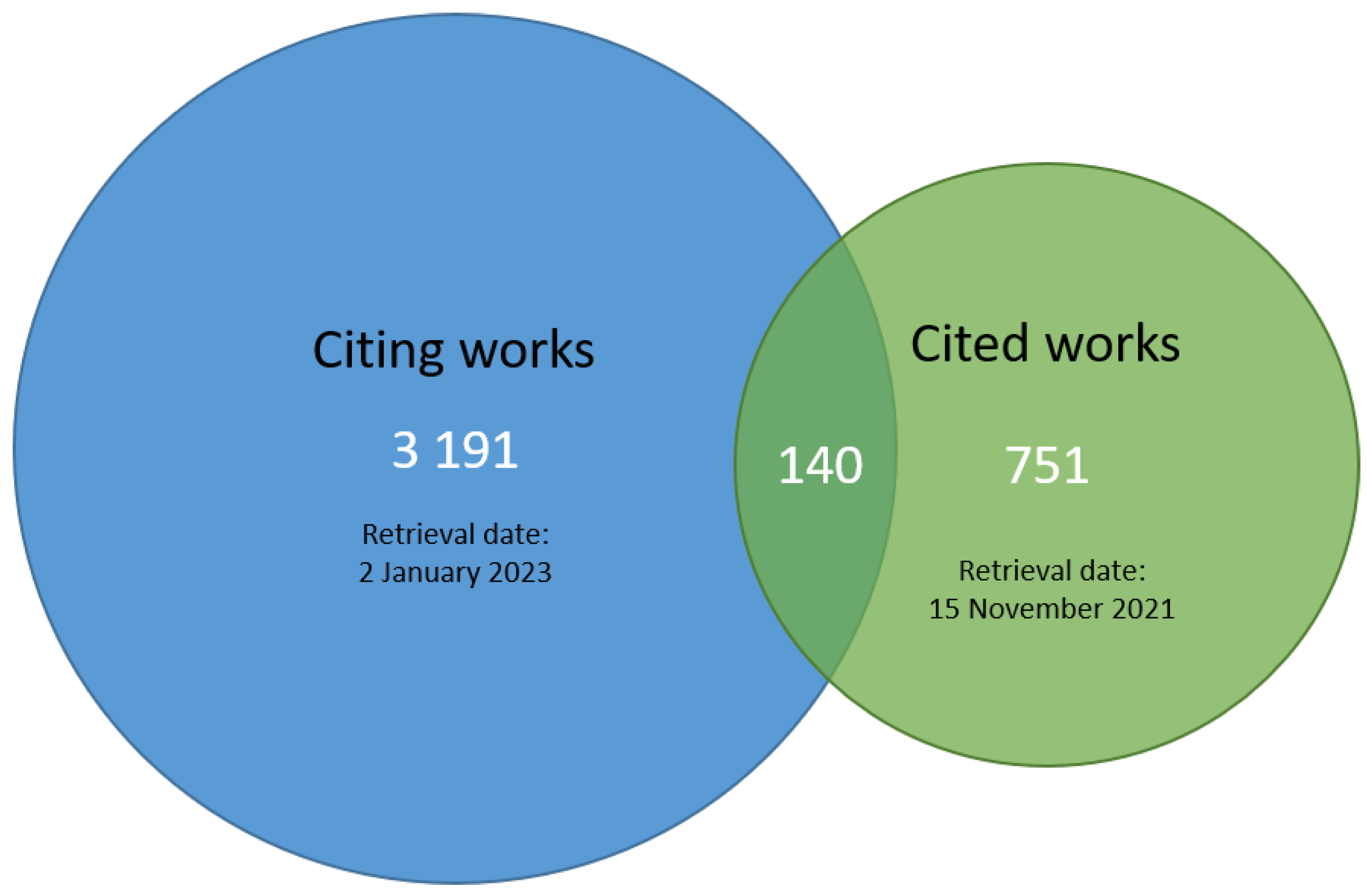
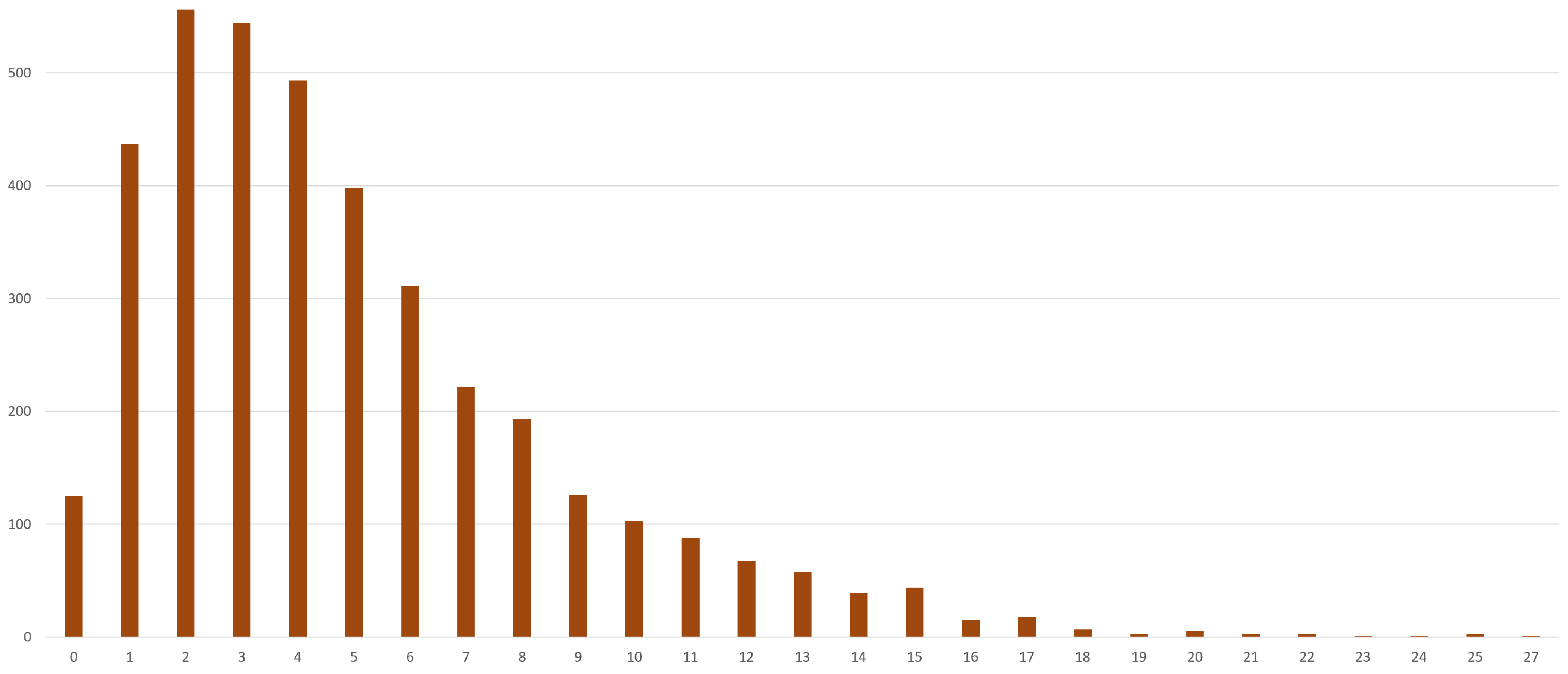
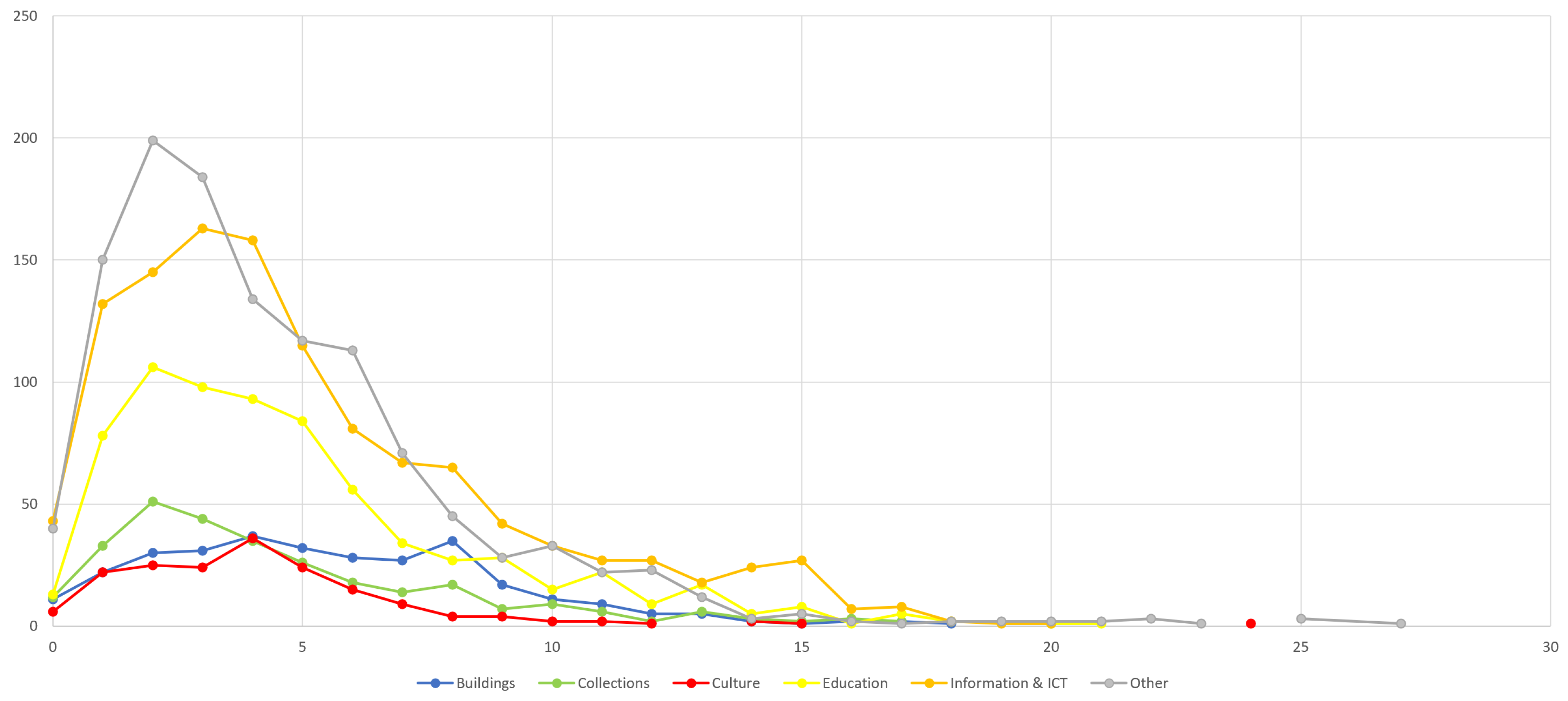
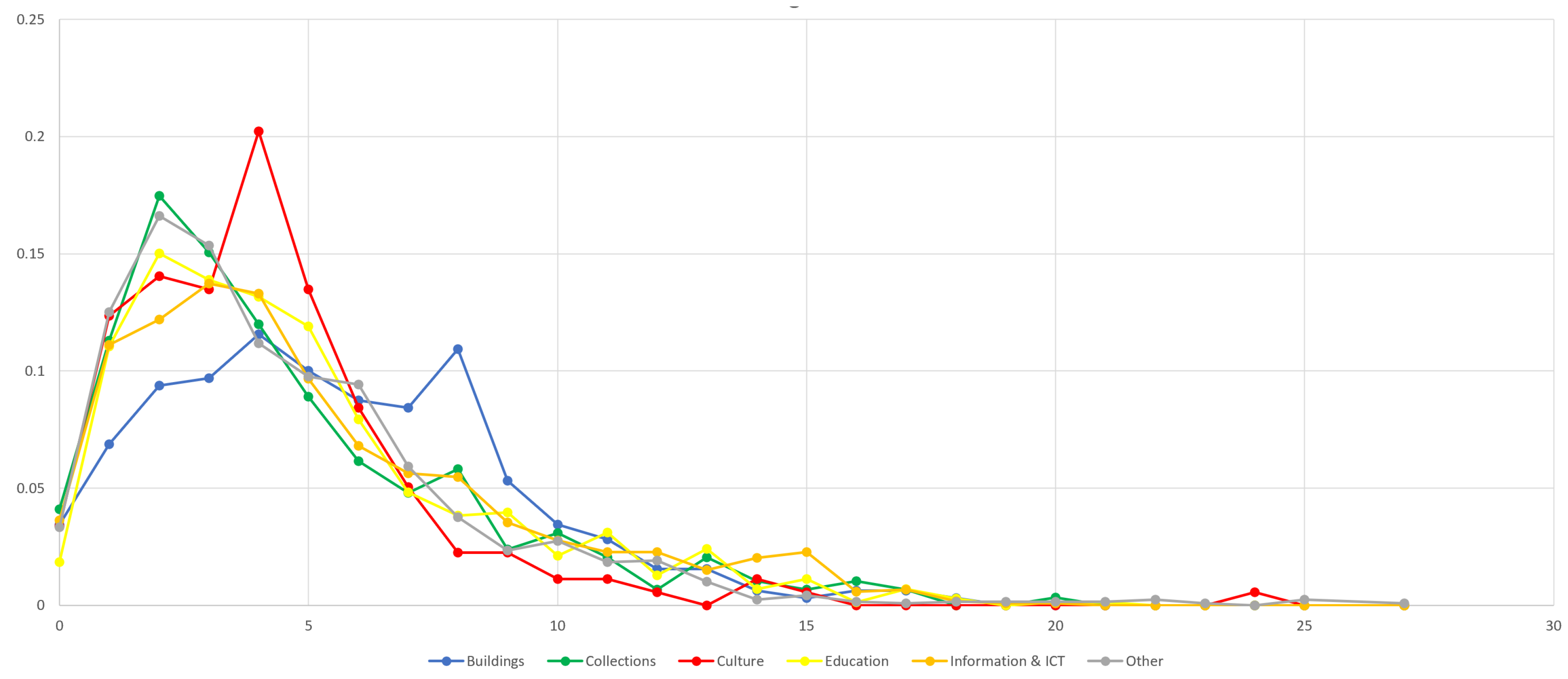
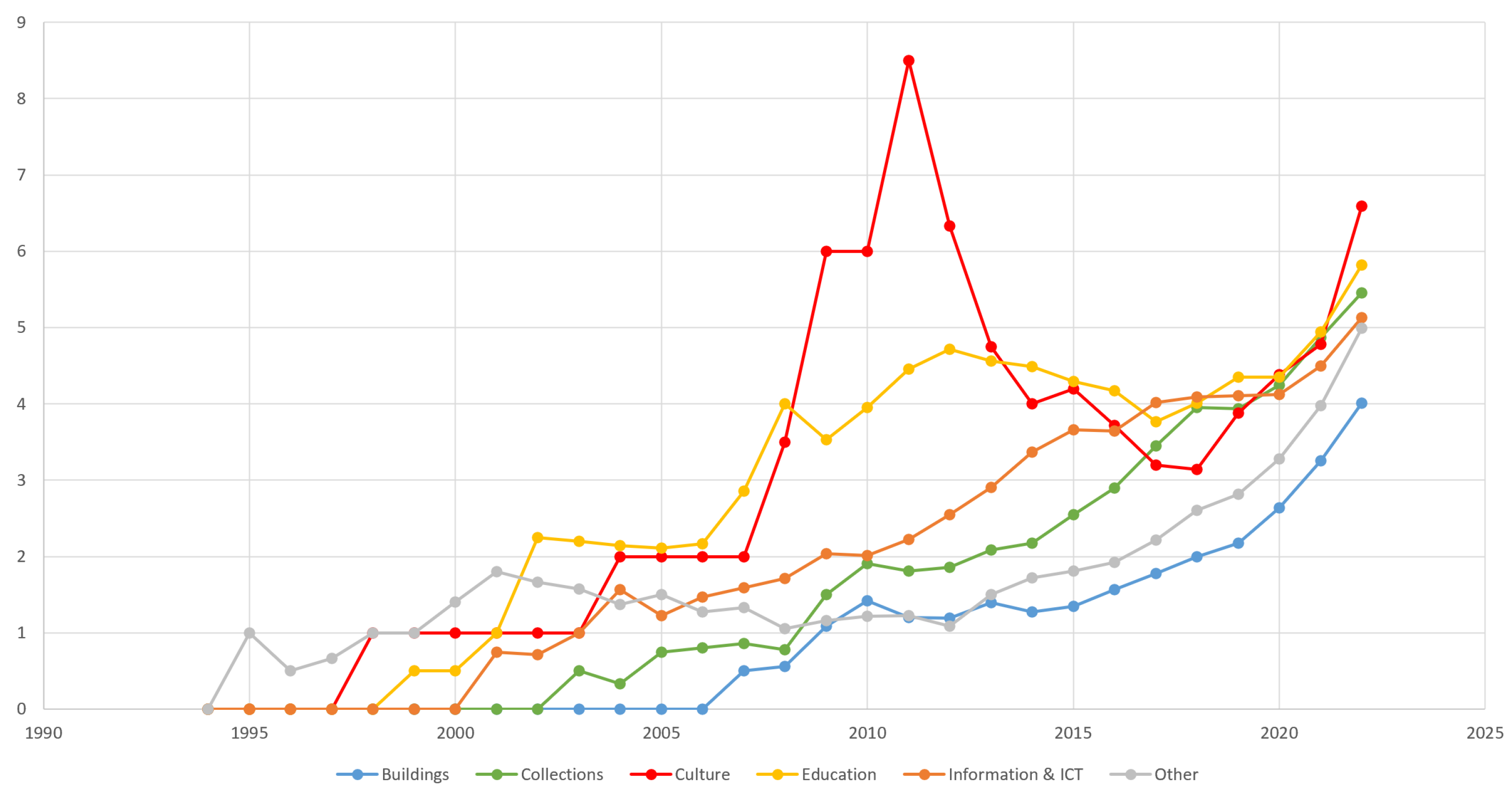
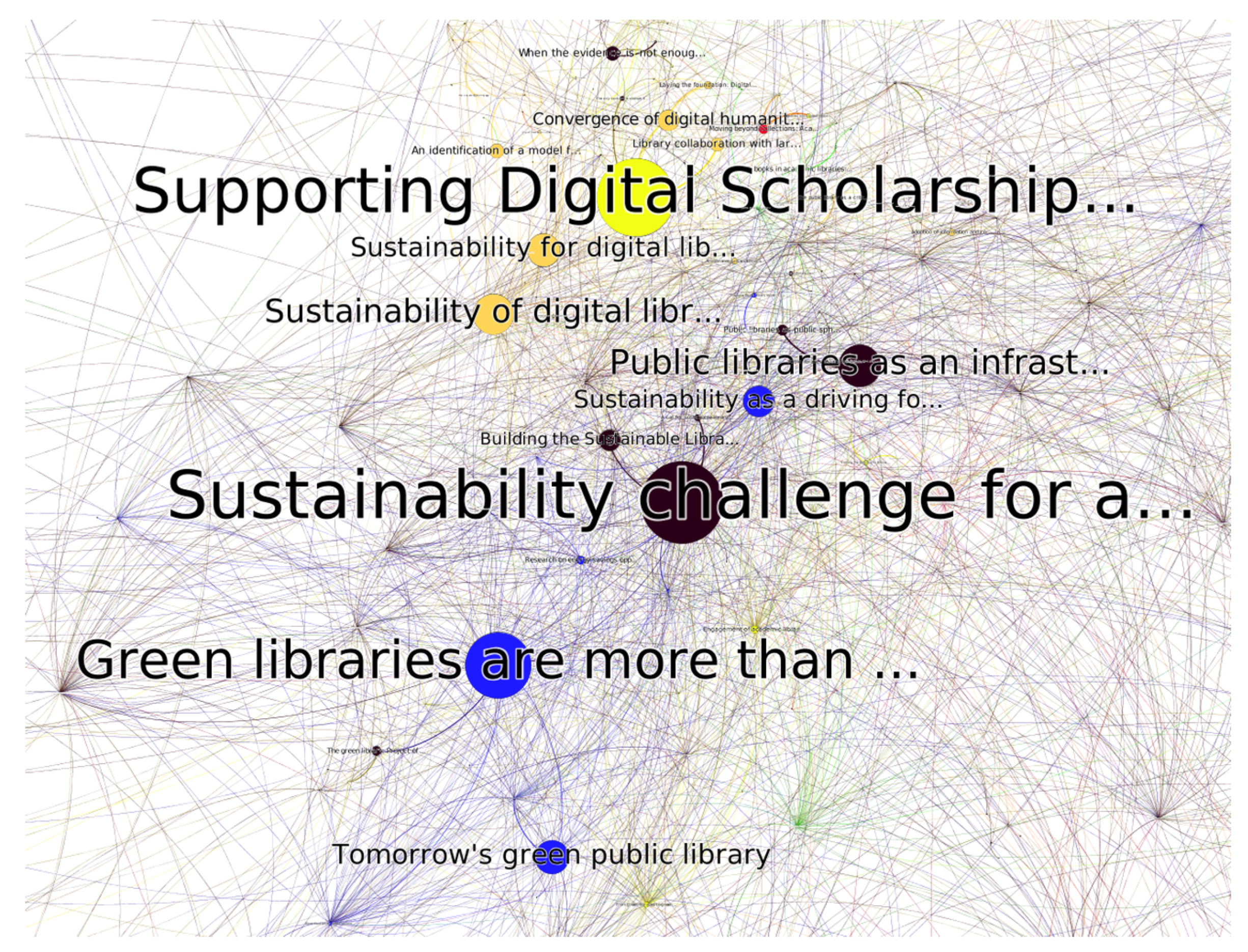
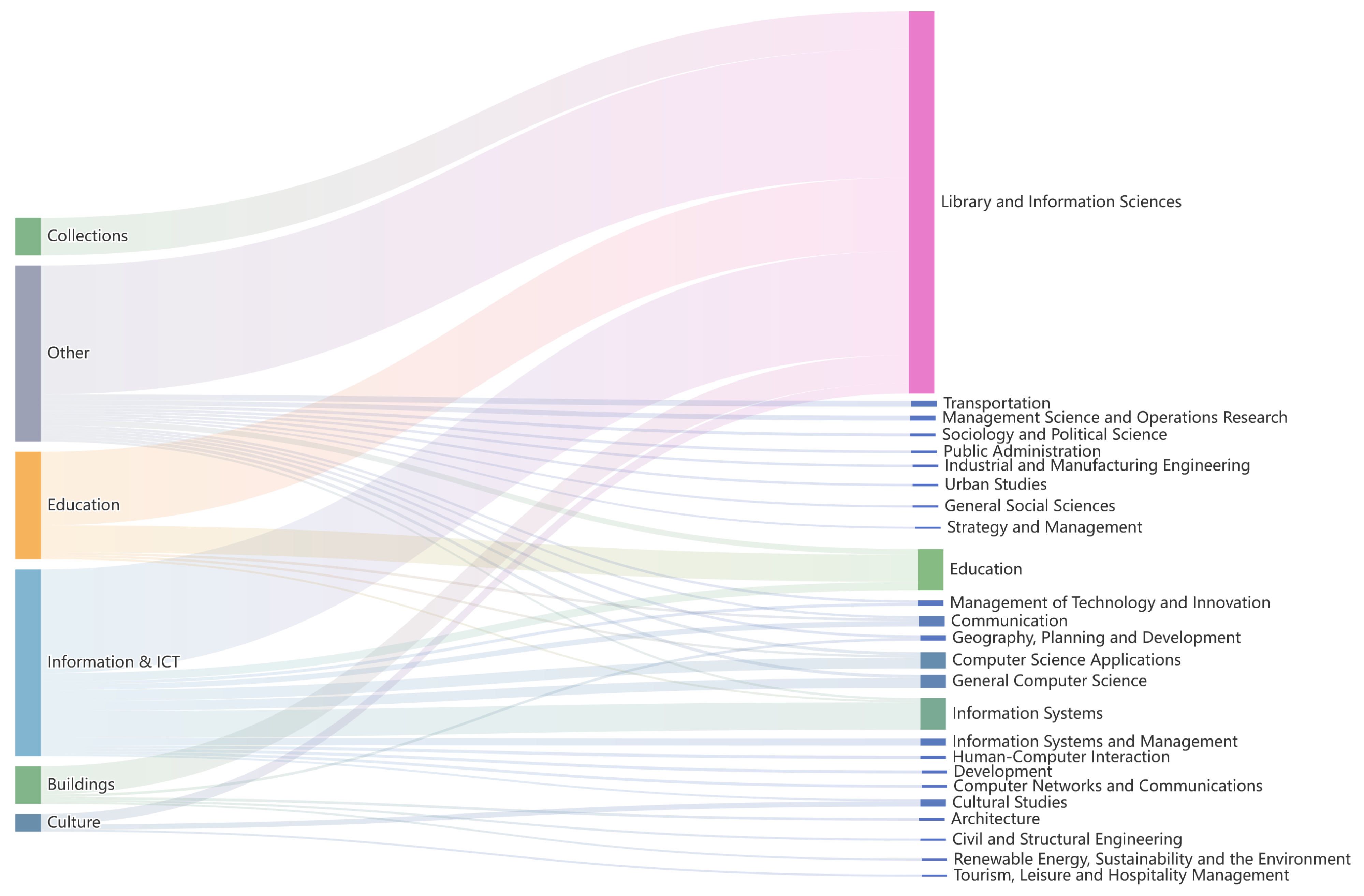
| Title | Citations Collected | Topical Area |
|---|---|---|
| Transport reduction by crowdsourced deliveries—a library case in Finland | 93 | Other |
| Supporting Digital Scholarship in Research Libraries: Scalability and Sustainability | 69 | Education |
| E-books in academic libraries: Challenges for acquisition and collection management | 68 | Collections |
| Cultural sustainability as a strategy for the survival of museums and libraries | 68 | Culture |
| Sustainability challenge for academic libraries: Planning for the future | 62 | Other |
| Teaching skills for teaching librarians: Postcards from the edge of the educational paradigm | 60 | Education |
| Adoption of information and communication technology (ICT) in academic libraries. A strategy for library networking in Nigeria | 40 | Information and ICT |
| How to choose a free and open source integrated library system | 39 | Information and ICT |
| Bridging the digital divide: The role of librarians and information professionals in the third millennium | 38 | Information and ICT |
| Convergence of digital humanities and digital libraries | 38 | Information and ICT |
| Preservation research and sustainable digital libraries | 38 | Information and ICT |
| When the evidence is not enough: Organizational factors that influence effective and successful library assessment | 36 | Other |
| Public libraries as an infrastructure for a sustainable public sphere: A comprehensive review of research | 33 | Other |
| Developing knowledge innovation culture of libraries | 32 | Information and ICT |
| Changing roles of reference librarians: The case of the HKUST Institutional Repository | 32 | Collections |
| Work Pair Titles |
|---|
| Personal librarian program for transfer students: an overview A boutique personal librarian program for transfer students |
| Library collaboration with large digital humanities projects Supporting Digital Scholarship in Research Libraries: Scalability and Sustainability (2) |
| Moving beyond collections: Academic library outreach to multicultural student centers Libraries and student affairs: Partners for student success |
| Copyright literacy in the UK: Results from a survey of library and information professionals Copyright literacy in finnish libraries, archives and museums |
| Public libraries as an infrastructure for a sustainable public sphere: A comprehensive review of research (4) Public libraries as public sphere institutions: A comparative study of perceptions of the public library’s role in six European countries |
| A call for sustainable library operations and services Sustainability challenge for academic libraries: Planning for the future (1) |
| Smart and sustainable library: Information literacy hub of a new city Public libraries as anchor institutions in smart communities: Current practices and future development |
| Supporting Digital Scholarship in Research Libraries: Scalability and Sustainability Convergence of digital humanities and digital libraries (10) |
| Convergence of digital humanities and digital libraries Laying the foundation: Digital humanities in academic libraries |
| Assessment in North American research libraries: A preliminary report card When the evidence is not enough: Organizational factors that influence effective and successful library assessment |
Disclaimer/Publisher’s Note: The statements, opinions and data contained in all publications are solely those of the individual author(s) and contributor(s) and not of MDPI and/or the editor(s). MDPI and/or the editor(s) disclaim responsibility for any injury to people or property resulting from any ideas, methods, instructions or products referred to in the content. |
© 2024 by the authors. Licensee MDPI, Basel, Switzerland. This article is an open access article distributed under the terms and conditions of the Creative Commons Attribution (CC BY) license (https://creativecommons.org/licenses/by/4.0/).
Share and Cite
Kamińska, A.M.; Opaliński, Ł.; Wyciślik, Ł. The Landscapes of Sustainability in Library and Information Science: Diachronous Citation Perspective. Sustainability 2024, 16, 9552. https://doi.org/10.3390/su16219552
Kamińska AM, Opaliński Ł, Wyciślik Ł. The Landscapes of Sustainability in Library and Information Science: Diachronous Citation Perspective. Sustainability. 2024; 16(21):9552. https://doi.org/10.3390/su16219552
Chicago/Turabian StyleKamińska, Anna Małgorzata, Łukasz Opaliński, and Łukasz Wyciślik. 2024. "The Landscapes of Sustainability in Library and Information Science: Diachronous Citation Perspective" Sustainability 16, no. 21: 9552. https://doi.org/10.3390/su16219552
APA StyleKamińska, A. M., Opaliński, Ł., & Wyciślik, Ł. (2024). The Landscapes of Sustainability in Library and Information Science: Diachronous Citation Perspective. Sustainability, 16(21), 9552. https://doi.org/10.3390/su16219552






